
USS Kearsarge, a Mohican-class sloop-of-war, is best known for her defeat of the Confederate commerce raider CSS Alabama during the American Civil War. Kearsarge was the only ship of the United States Navy named for Mount Kearsarge in New Hampshire. Subsequent ships were later named Kearsarge in honor of the ship.
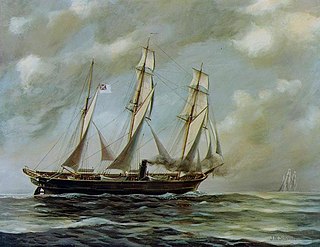
CSS Alabama was a screw sloop-of-war built in 1862 for the Confederate States Navy at Birkenhead on the River Mersey opposite Liverpool, England by John Laird Sons and Company. Alabama served as a successful commerce raider, attacking Union merchant and naval ships over the course of her two-year career, during which she never docked at a Southern port. She was sunk in June 1864 by USS Kearsarge at the Battle of Cherbourg outside the port of Cherbourg, France.
The second USS Florida was a sidewheel steamer in the United States Navy.
The first USS Sacramento was a sloop-of-war in the United States Navy.

CSS Shenandoah, formerly Sea King, later El Majidi, was an iron-framed, teak-planked, full-rigged sailing ship with auxiliary steam power chiefly known for her actions under Lieutenant Commander James Waddell as part of the Confederate States Navy during the American Civil War.
CSS Raleigh was originally a small, iron-hulled, propeller-driven towing steamer operating on the Albemarle and Chesapeake Canal. She was taken over by the State of North Carolina in May 1861, and transferred to the Confederate States the following July. Her commanding officer during 1861–1862 was Lieutenant Joseph W. Alexander. Her entire service was in coastal waters of North Carolina and Virginia and in the James River as part of the James River Squadron.

CSS Robert E. Lee was a blockade runner for the Confederate States during the American Civil War that later served in the United States Navy as USS Fort Donelson and in the Chilean Navy as Concepción.
The CSS Beaufort was an iron-hull gunboat that served in North Carolina and Virginia during the Civil War.
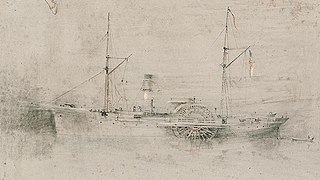
USSKeystone State was a wooden sidewheel steamer that served in the Union Navy during the American Civil War.
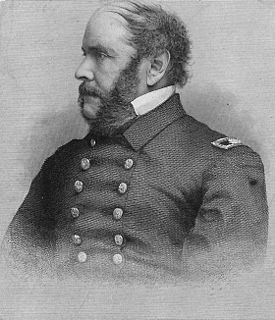
John Ancrum Winslow was an officer in the United States Navy during the Mexican–American War and the American Civil War. He was in command of the steam sloop of war USS Kearsarge during her historic 1864 action off Cherbourg, France with the Confederate sea raider CSS Alabama.
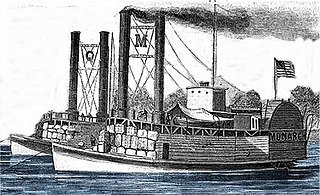
USS Monarch was a United States Army sidewheel ram that saw service in the American Civil War as part of the United States Ram Fleet and the Mississippi Marine Brigade. She operated on the Mississippi River and Yazoo River during 1862 and 1863.

The first USS Nereus, a screw steamer built at New York in 1863, was purchased by the Union Navy from William P. Williams on 5 October 1863; and commissioned at New York Navy Yard 19 April 1864, Commander John C. Howell in command.

USS Vanderbilt (1862) was a heavy (3,360-ton) passenger steamship obtained by the Union Navy during the second year of the American Civil War and utilized as a cruiser.
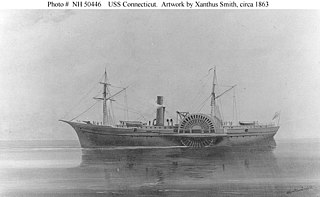
USS Connecticut (1861) was a large steamer acquired by the Union Navy during the American Civil War. Her primary task was to prevent ships from penetrating the Union blockade of Southern ports.

USS Calhoun was a captured Confederate steamer and blockade runner acquired by the Union Navy from the prize court during the American Civil War.

The first USS Emma was a steamer captured by the Union Navy during the American Civil War. She was used by the Union Navy as a picket and patrol vessel on Confederate waterways.

The blockade runners of the American Civil War were seagoing steam ships that were used to get through the Union blockade that extended some 3,500 miles (5,600 km) along the Atlantic and Gulf of Mexico coastlines and the lower Mississippi River. The Confederate states were largely without industrial capability and could not provide the quantity of arms and other supplies needed to fight against the industrial north. Blockade runners built in Scotland and England met this need and imported the guns, ordnance and other supplies that the Confederacy desperately needed, in exchange for cotton that the British textile industry likewise was in desperate need of. To get through the blockade, these relatively lightweight shallow draft ships, mostly built in British ship yards and specially designed for speed, had to cruise undetected, usually at night, through the Union blockade. The typical blockade runners were privately owned vessels often operating with a letter of marque issued by the Confederate States of America. If spotted, the blockade runners would attempt to outmaneuver or simply outrun any Union ships on blockade patrol, very often successfully.
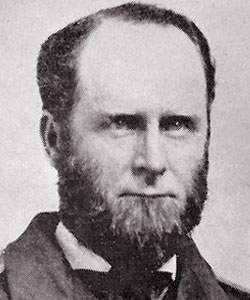
John McIntosh Kell was an officer in the Confederate navy during the American Civil War, during which time Kell was First Lieutenant and Executive Officer of the commerce raider CSS Alabama.














